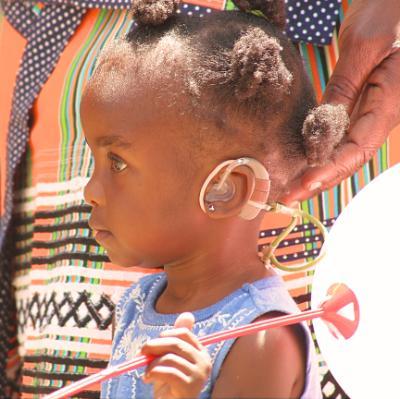What to do if hearing loss is suspected?
If you suspect that your baby or child doesn't hear properly – get help right away!
What if hearing loss is suspected?
The first few years of a child's life are when language is acquired. If he or she is not exposed to sound, speech will not develop naturally.
Early intervention is the key to enabling natural development of Deaf and hard of hearing infants – but how early is early? Ideally the child should be screened by the age of one month, diagnosed by three months and be on the HI HOPES programme by six months.
Look out for tell-tale signs that your baby does not hear properly, and arrange to have him or her screened by an audiologist.
How will my child's hearing be tested?
There are several different tests that may be conducted.
Otoacoustic Emission Testing (OAE)
A small probe is placed in the child's ear canal. A tone is sent into the ear and an echo is recorded from a healthy cochlea. Absence of an echo indicates a problem. This test requires no response from the child and is used as a screening procedure.
Auditory Brainstem Response (ABR)
Electrodes that measure the brainstem's electrical response to sound are attached to the child's head. The tester then determines the softest sound that will get a response from the brainstem. Older children need to be sedated for this test as movement affects results.
Behavioural Observation Audiometry (BOA)
Hearing is tested by watching for changes in the child's behaviour in response to sound. A sound is presented through speakers and a response like a blink, smile or startle may be an indication that the sound was heard.
Older children can be tested using Visual Response Audiometry: the child turns his or her head in response to a sound presented from a speaker and receives visual reinforcement, or Play Audiometry: the child responds to sound presented through earphones by playing a game, e.g. putting a peg in a board when they hear a sound, or Pure tone Audiometry: the child wears headphones and lifts his/her hand when a sound is heard.
What causes hearing loss in a child?

A baby may be born Deaf, lose his or her hearing as a result of meningitis or an ear infection, or the cause may be hereditary.
The ear has three parts: the outer ear is made up of the pinna (what you see on the outside of the head) and ear canal; the middle ear comprises the eardrum, middle ear bones and Eustachian tube; and the inner ear is made up of the cochlea (organ of hearing), semicircular canals (help with balance) and part of the auditory nerve.
Depending on the part of the ear that is affected, there are different treatment options.
-
Conductive hearing loss is caused by problems in the outer/middle ear. There is an interference with the transmission of sound through the outer and middle ear, but sounds still reach the cochlea. Softer sounds will not be heard and sound quality may be compromised. This type of hearing loss can often be treated medically or surgically.
-
Sensorineural hearing loss is caused by problems in the inner ear including the cochlea and auditory nerve. Most common cause is damage to hair cells in the cochlea so that nerve cells cannot send signals to the brain. This is a permanent hearing loss and cannot be treated medically/surgically.
-
Central hearing loss – sound is transmitted to the auditory nerve but it is not processed normally along the auditory nerve and/or in the brain.


